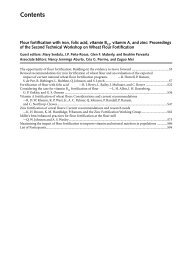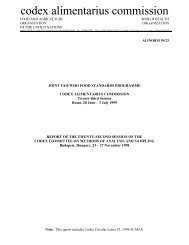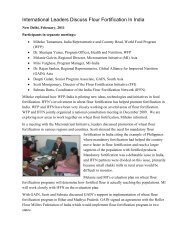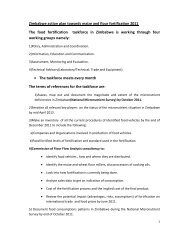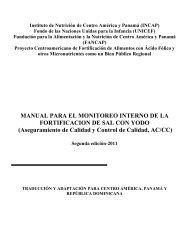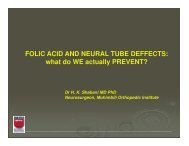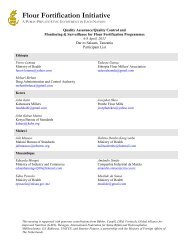Nutriview - Flour Fortification Initiative
Nutriview - Flour Fortification Initiative
Nutriview - Flour Fortification Initiative
Create successful ePaper yourself
Turn your PDF publications into a flip-book with our unique Google optimized e-Paper software.
<strong>Nutriview</strong> 2005/1 4<br />
Table 1: SUSTAIN consensus on choice of iron enhancing technology for fortified foods<br />
Strategy Suitability Effect Limitations Relative cost*<br />
Ascorbic acid<br />
Other organic acids<br />
(e.g. citric, lactic, tartaric<br />
acids)<br />
Iron EDTA chelates<br />
(NaFeEDTA)<br />
Amino acid chelates<br />
(e.g. ferrous bisglycinate)<br />
Phytate degradation<br />
Microencapsulation<br />
of ferrous sulfate/ferrous<br />
fumarate in oil<br />
Dry products (e.g. powdered<br />
milk, precooked<br />
infant foods). Effective<br />
in molar ratio 2:1 (low<br />
phytate content) to 4:1<br />
(high phytate content).<br />
Fruit drinks. Effective<br />
only at high molar<br />
ratios (>100:1 acid:iron).<br />
Soy and fish sauce;<br />
condiments;<br />
high-phytate flours.<br />
No adverse effect on<br />
metabolism of other<br />
nutritionally important<br />
metals.<br />
Milk and beverages.<br />
Cereal- and legumebased<br />
weaning foods.<br />
Dry products stored at<br />
low temperatures (e.g.<br />
infant foods, condiments,<br />
“sprinkles”).<br />
2–3x dose-dependent<br />
increase in iron absorption<br />
(intrinsic and added<br />
iron)<br />
Iron bioavailability from<br />
high-phytate meals 2–3<br />
times higher than with<br />
ferrous sulfate.<br />
Iron bioavailability from<br />
bread and milk 2–3 times<br />
higher than with ferrous<br />
sulfate.<br />
Complete phytate removal<br />
can improve iron absorption<br />
2–12 fold.<br />
Resolves sensory and<br />
stability issues that limit<br />
addition of soluble iron<br />
forms to foods. May protect<br />
against oxidation.<br />
Instability in aqueous solutions<br />
and during prolonged heat processing.<br />
Needs packaging that<br />
excludes oxygen.<br />
Cause unacceptable flavor<br />
changes in most foods<br />
Ambiguous regulatory status.<br />
Not recommended for infant<br />
foods. Packaging needs to<br />
protect EDTA against UV<br />
degradation.<br />
Additional research on stability<br />
and organoleptic effects needed.<br />
5.0–7.0<br />
4.6–14.8<br />
Further research needed. 7.1–18.5<br />
Requires near-complete removal<br />
of phytate to work.<br />
Food preparation involving heat<br />
may melt the capsule material<br />
and result in unacceptable<br />
organoleptic changes.<br />
See footnote**<br />
2.15–8.4<br />
* This calculation is based on the cost of a fortification strategy expected to the have same impact on iron status as 10 mg ferrous sulfate<br />
used alone (relative cost = 1.0). The comparison to ferrous sulfate was made because it is a commonly used iron fortificant, not<br />
because it is necessarily the preferred choice. The use of different enhancers is food-product specific, so this analysis should not be<br />
used to rank enhancers or make direct comparisons between an enhancer and ferrous sulfate. It only indicates the relative cost of<br />
the enhancer when used in an appropriate food vehicle.<br />
** The SUSTAIN analysis suggests that commercial phytate removal from flour would be expensive when compared with other<br />
enhancing technologies (estimate based on medium-to-high-volume production with prolonged processing at controlled temperature,<br />
ten years’ depreciation on capital expenditure and labor costs, as well as cost of the degradation agent). Other approaches,<br />
such as soaking and germination, fermentation, and addition of phytase to ready-to-eat foods (for activation during digestion) might<br />
be more economical, but were not taken into consideration for this calculation.<br />
Effective fortification depends on the<br />
selection of technically feasible and efficacious<br />
strategies. Once suitable strategies<br />
have been identified cost becomes very<br />
important in selecting the best approach<br />
to implement. However it is essential to<br />
calculate cost in relation to the amount<br />
of bioavailable iron delivered. ■<br />
This information is taken from the 2004<br />
SUSTAIN Task Force Report: “Enhancing the<br />
Absorption of <strong>Fortification</strong> Iron”. Members<br />
of the Task force are: Richard Hurrell 1 , Sean<br />
Lynch 2 , Thomas Bothwell 3 , Héctor Cori 4 , Ray<br />
Glahn 5 , Eva Hertrampf 6 , Zdenek Kratky 7 ,<br />
Dennis Miller 8 , Mario Rodenstein 9 , Hugo<br />
Streekstra 10 , Birgit Teucher 11 , Elizabeth<br />
Turner 12 , C. K. Yeung 8 , Michael Zimmermann 1<br />
1<br />
Institute of Food Science and Nutrition,<br />
Swiss Federal Institute of Technology<br />
Zurich, Switzerland; 2 Eastern Virginia<br />
Medical School, Norfolk, Virginia, USA;<br />
3<br />
Department of Medicine, University of<br />
Witwatersrand, Johannesburg, South Africa;<br />
4<br />
DSM Nutritional Products, Santiago, Chile;<br />
5<br />
USDA-ARS Plant Soil and Nutrition<br />
Laboratory, Ithaca, New York, USA; 6<br />
Institute of Nutrition and Food Technology,<br />
Santiago, Chile; 7 Nestlé, New Milford,<br />
Connecticut, USA; 8 Department of Food<br />
Science, Cornell University, Ithaca, New<br />
York, USA; 9 Unilever, Englewood Cliffs,<br />
New Jersey, USA; 10 DSM Food Specialties,<br />
Delft, Netherlands; 11 Institute of Food<br />
Research, Norwich Laboratory, Norwich,<br />
UK; 12 SUSTAIN, Washington, DC, USA.




